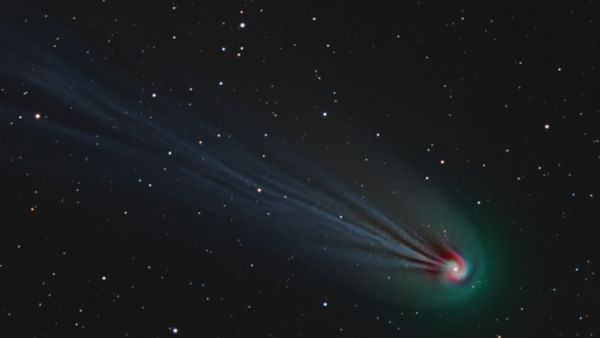An unusual “horned” comet is now visible in the night sky — and it may even make a rare appearance during the 2024 total solar eclipse on April 8.
Comet 12P/Pons-Brooks can currently be seen in the night skies of the northern hemisphere. Comets, composed of dust, rock and ices, heat up and expel gas when their orbits bring them closer to the sun, creating a glowing halo around the comet itself known as a coma. Outbursts observed from Comet 12P give it a horned-like appearance, earning it nicknames such as “Devil Comet” and “Millennium Falcon.”
This particular comet visits the inner solar system every 71 years. It will make its closest approach to the sun on April 21, passing within 74.4 million miles (119.7 million kilometers) of our star. This means the comet will be fairly close to the sun during the total solar eclipse of April 8 that is set to pass over Mexico, 15 U.S. States and Canada, according to EarthSky.org.
Related: Amazing photos of ‘horned’ comet 12P/Pons-Brooks from around the world
“During the total eclipse, when the sky darkens, you’ll see the brightest planet Venus pop into view on one side of the sun,” according to EarthSky.org. “On the other side of the sun, you’ll find the second-brightest planet, Jupiter. And if Comet Pons-Brooks is bright enough, you’ll see it between Jupiter and the sun, but closer to Jupiter.”
A solar eclipse occurs when the moon passes between Earth and the sun, casting a shadow on our planet’s surface. For those in the path of totality, the moon appears almost exactly the same size as the sun, so it blocks the entire disk for a few minutes. This means the comet may be just barely visible to the naked eye, or at least by using binoculars.
The visibility of Comet 12P during the eclipse will ultimately depend on its brightness that day. If the comet has one of its dramatic outbursts, that would increase the size of its halo and cause it to appear brighter. While this won’t be the first time a comet has appeared alongside a total solar eclipse, it is relatively rare to see these phenomena coincide.
If you’re planning to watch the solar eclipse on April 8, or hunt for Comet 12P in general, be sure to check out our guide about how to observe the sun safely. Everyone observing the partial phases of this eclipse will need to wear solar eclipse glasses and equip cameras, telescopes and binoculars with a solar filter at all times.
Keep up to date with the latest eclipse content on our eclipse live blog and watch all the total eclipse action unfold live here on Space.com.
Editor’s Note: If you snap an amazing solar eclipse or Comet 12P photo and would like to share it with Space.com’s readers, send your photo(s), comments, and your name and location to [email protected].

Dr. Thomas Hughes is a UK-based scientist and science communicator who makes complex topics accessible to readers. His articles explore breakthroughs in various scientific disciplines, from space exploration to cutting-edge research.








